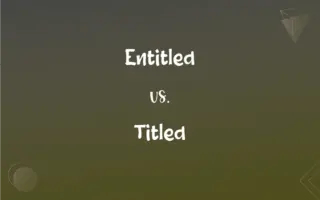Dracula vs. Vampire: What's the Difference?
Edited by Janet White || By Harlon Moss || Updated on October 6, 2023
Dracula is a fictional vampire character created by Bram Stoker, while a vampire is a mythical creature believed to feed on the blood of the living.

Key Differences
Dracula is a specific character, originating from Bram Stoker's 1897 gothic horror novel of the same name. This character has become an iconic figure in the horror genre and is often conflated with general vampire lore. Dracula, being of Transylvanian nobility, exhibits particular manners, style, and a distinct personality in the novel, displaying a mix of charm and malevolence.
Vampires, on the other hand, span numerous cultures and their myths date back thousands of years. These creatures of the night are typically said to feed on the blood of the living to maintain their own vitality. Vampires are often portrayed with a variety of characteristics, such as being immortal, sensitive to sunlight, and having a fear of garlic and holy symbols.
Dracula, while being a vampire, is also depicted with some unique abilities and characteristics that distinguish him from traditional vampire mythology. For instance, Stoker’s Dracula can shape-shift into various forms, including a bat, a wolf, and even mist. Furthermore, Dracula is often portrayed as being particularly cunning and intelligent, qualities that are not always attributed to vampires in general.
In contrast, vampire myths are varied and differ widely across cultures. Some beliefs posit that vampires are revenants of evil beings, suicide victims, or witches, while others depict them as seductive and alluring. Furthermore, the method of becoming a vampire, their abilities, and ways they can be destroyed or repelled also differ widely in various folklore.
Dracula's characterization and narrative have played a significant role in shaping modern vampire mythology. Stoker's novel combined various regional myths and folklore (from Eastern Europe and beyond) to establish many of the tropes that are now widely associated with vampires in popular culture. On the other hand, vampires as a mythological or folklore entity exist independently of the Dracula narrative and are malleable to different cultural contexts and interpretations.
ADVERTISEMENT
Comparison Chart
Definition
A specific fictional character from a novel
A mythical creature from various folklores
Origin
Created by Bram Stoker in 1897
Myths exist worldwide, dating back millennia
Characteristics
Noble, articulate, specific powers
Generally nocturnal, blood-feeding entities
Role in Media
Often a singular antagonist
Can be protagonists, antagonists, etc.
Cultural Context
Largely bound to Stoker’s depiction
Varies widely across different cultures
ADVERTISEMENT
Dracula and Vampire Definitions
Dracula
Iconic Vampire.
Dracula is often mistakenly used as a synonym for vampires due to his iconic status.
Vampire
Pop Culture Entity.
Vampires are popular entities in movies, literature, and television series.
Dracula
Historical Figure.
Some believe Dracula was inspired by Vlad the Impaler, a brutal historical figure.
Vampire
Folklore Figure.
Vampires appear in folklore, with varying characteristics and origins.
Dracula
Literary Character.
Dracula, a count from Transylvania, is one of literature's most famous antagonists.
Vampire
Mythical Creature.
Vampires are mythical beings that consume the blood of the living.
Dracula
Film Character.
Dracula has been adapted into various films, becoming a staple in horror cinema.
Vampire
A vampire bat.
Dracula
Cultural Symbol.
Dracula has transcended literature to become a symbol of vampirism and sometimes evil.
Vampire
Symbol of Fear.
In various narratives, vampires are used as symbols of fear and the unknown.
Dracula
Comprises tropical American species usually placed in genus Masdevallia: diminutive plants having bizarre and often sinister-looking flowers with pendulous scapes and motile lips
Vampire
Immortal Beings.
Vampires are often depicted as immortal, living indefinitely unless killed.
Dracula
Fictional vampire in a gothic horror novel by Bram Stoker
Vampire
In popular folklore, an undead being in human form that survives by sucking the blood of living people, especially at night.
Vampire
A person, such as an extortionist, who takes advantage of others, especially for personal gain.
FAQs
Are vampires real?
Vampires are mythical and do not have a basis in scientific reality, often featuring in folklore and fiction.
Is Dracula a real historical figure?
Dracula is based in part on Vlad the Impaler, a real 15th-century prince in Wallachia, but as a vampire, Dracula is fictional.
What is Dracula?
Dracula is a fictional vampire character from Bram Stoker's 1897 novel, often depicted as a Transylvanian nobleman.
What is a vampire?
A vampire is a mythical creature, believed to be undead and to sustain itself by feeding on the blood of the living.
Why is Dracula famous?
Dracula is famous due to Bram Stoker's novel and numerous adaptations in films, TV shows, and other media, becoming synonymous with vampirism.
Are there different types of vampires?
Yes, vampire myths vary globally, with different cultures having distinct beliefs regarding characteristics, abilities, and weaknesses of vampires.
Is Dracula the first vampire in literature?
No, vampires appeared in literature before Dracula, such as in John Polidori’s “The Vampyre” (1819).
Why is Dracula associated with bats?
Dracula can transform into a bat in Stoker’s novel, and bats are often linked to vampire lore due to their nocturnal habits and blood-feeding species.
How does one become a vampire, according to myths?
Myths vary, but common themes include being bitten by a vampire, undergoing a special ritual, or suffering a curse.
Is Dracula a typical representation of vampires?
While Dracula has influenced the modern vampire archetype, he also has unique characteristics and doesn't fully represent all vampire myths.
How do vampires appear in modern media?
Vampires in modern media are highly varied, ranging from horror antagonists to romantic figures or complex characters.
Do vampires have a reflection?
Traditionally, vampires are said not to cast a reflection or appear in photographs, although this can depend on the specific myth or story.
What are common vampire weaknesses?
Commonly, vampires are depicted as being repelled by garlic, sunlight, and holy symbols, and can be killed with a stake through the heart.
Can Dracula turn into other creatures?
Yes, in Stoker’s novel, Dracula can transform into a bat, wolf, and mist, among other entities.
Are vampires evil in all cultural depictions?
Not always. While often depicted as malevolent, some cultures and stories portray vampires more sympathetically or even as benevolent beings.
Was Dracula the first appearance of vampires in pop culture?
No, vampires appeared in pop culture prior to Dracula, but Stoker's novel greatly popularized them and shaped their modern image.
Why do vampires drink blood?
In most myths, vampires drink blood to sustain themselves, gain strength, or maintain immortality.
How can Dracula be killed?
In the novel, Dracula is killed with a knife through the heart, but methods can vary across different adaptations.
Do vampires have powers?
In various tales, vampires have powers like super strength, hypnotism, shape-shifting, and more, but abilities can differ widely.
Can Dracula and vampires be considered similar?
While Dracula is a vampire, not all vampires conform to his specific characteristics, origins, or abilities.
About Author
Written by
Harlon MossHarlon is a seasoned quality moderator and accomplished content writer for Difference Wiki. An alumnus of the prestigious University of California, he earned his degree in Computer Science. Leveraging his academic background, Harlon brings a meticulous and informed perspective to his work, ensuring content accuracy and excellence.
Edited by
Janet WhiteJanet White has been an esteemed writer and blogger for Difference Wiki. Holding a Master's degree in Science and Medical Journalism from the prestigious Boston University, she has consistently demonstrated her expertise and passion for her field. When she's not immersed in her work, Janet relishes her time exercising, delving into a good book, and cherishing moments with friends and family.







































































